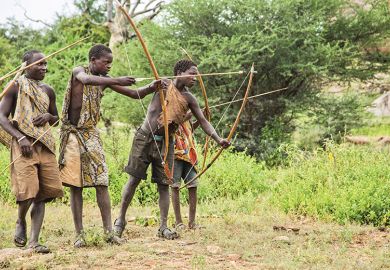The environmental behaviour of indigenous peoples is the subject of fierce contention. It has become a matter of political correctness to argue that so-called indigenous peoples - whether American Indian, Australian or Indian Aborigines, Eskimo or others - have always been fastidious guardians and sensitive managers of the environment. This political fashion is, in part, a reaction to a historical tendency by colonials to construct them as environmentally profligate barbarians. By contrast, many natural scientists (and others) are increasingly questioning the veracity of assertions about their ecological purity.
Shepard Krech's timely book wades into this academic hornet's nest by researching the history of the construction of the American Indian as ecologically conscientious, a myth that postdates the 1960s, and by investigating the evidence for the ecological behaviour and impact of American indigenous peoples. Since the accidental discovery of "Kennewick Man" in 1996, the debate has become even more complex. A skull found by two teenagers on the banks of the Columbia River, in Washington state, produced a radiocarbon date indicating the skeleton was about 9,000 years old. A salvage archaeologist, Richard Chatters, identified the skull as "Caucasoid" rather than Native American. This truly set the cat among the politically correct pigeons. For who actually colonised the Americas and who constitute "indigenous people"?
This question has been an internationally important one because indigenous claims to land, prior ownership, self-government and ethnic identity are increasingly being made in terms of competence in environmental management. If a fundamental doubt had been raised about the racial and ethnic identity of the original settlers, all subsequent political claims based on an accepted identity could be undermined, as has been raised in the United States, Canada, Australia, India and Bangladesh, to name but a few countries. To protect claims made on this basis, some political groupings, including some academics, have deemed it necessary to stifle research and debate on the identity and historical behaviour of so-called indigenous peoples (itself a problematic term).
A concern about this worrying intellectual development underlies Krech's book. Stifling of research can attempt to advance an indigenous cause or to suppress notions of indigenous identity and ecological and cultural separateness. In India, the political and academic establishment has sought in effect to deny the identity of the roughly 80 million indigenous people by decrying the use of the term tribal as a neo-colonial term. However, such attempts to suppress the expression of tribal identity have served instead to strengthen movements for autonomy. The recent successful campaign to establish a Jharkhand state has rested on coupled notions of ethnic identity and superior ecological competence in the face of rapid deforestation.
In New Zealand, by contrast, the strength of the Maori political interest has made proper academic discussion of the undoubted prehistory of Maori predecessors, especially the Woriori peoples (who appear to have been wiped out by Maoris on the New Zealand mainland) practically impossible.
But perhaps the most problematic instance is found in Australia. By an act of extraordinary intellectual juggling, it became possible to postulate theories of massive landscape transformation by indigenous people and yet to deny emphatically that indigenous Australians had played a role in the extinction of the Pleistocene megafauna, the giant birds and marsupials among which they lived and hunted.
This denial has become an essential component of the concept of the "ecological Aborigine". We have reached a stage in Australia where this reviewer could be described by The Canberra Times as a "purveyor of fake racist science" merely for suggesting that Aborigines were responsible for the extinction of the marsupial megafauna.
Another problem for indigenous ecological exceptionalism stems from the growing evidence that in the peopling of many continents, there was no ethnic or racial homogeneity. In North America, as the extraordinary story of Kennewick Man shows, a variety of "racial" groups may have been involved in a process of settlement that may have been going on for much longer than traditionally espoused, for up to 30,000 years perhaps. In Australia, it is becoming clear that a wholesale shift in "tool culture" and population distribution took place 6,000-5,000 years ago. New groups of Austronesians entered Australia, bringing with them the dingo and a variety of new languages, probably due to the onset of the El Niño phenomenon. The question of whether they displaced the original population has, however, become politically impossible to debate.
The inherent dangers of portraying indigenous peoples as pacifist custodians are succinctly demonstrated by Krech: "Those who despair at the pace and extent of environmental change at the end of the millennium, are blind to the environmental impacts of pre-industrial societies and adhere to the notion that native indigenous people have always represented a kinder gentler way of relating to the environment will no doubt be disturbed by this book's conclusions."
Since the start of the modern environmental movement, many have looked for less destructive ways of relating to nature than the pursuits of convenience and economic gain allow. Some look towards an alternative "ecological" Christianity, others to Taoism, to Buddhism or to the indigenous communities' thoughts on the living world. Many native people themselves draw on a tradition of texts promulgating noble imagery that has generally had deeper roots in European self-criticism than in indigenous realities.
Given the appropriation of aboriginal lands in many countries and the vast and often destructive changes wrought by people of European descent, one can understand the reasons for the emergence and persistence of the "purified" image of native people. But when attempts are made to ringfence the indigenous "image" with a mindset of stasis or of political correctness, a serious challenge is made to intellectual integrity.
A large part of the book is devoted to detailing the very extensive use made of fire by American Indians in transforming the landscape in a continual cycle of fire and regrowth, and to detailing the impact of Indians upon the fauna of North America. Krech is most controversial in his description of the societies such as the Hohokam and the O'odham that flourished in the wetter periods of the Medieval Warm Period in what is now semi-arid North America. He is unable to account for these declines.
However, recent research indicates that the decline of these groups, like the decline of the Maya or the Indus civilisations, was probably due to the passage of extreme climate events, such as El Niño and La Niña. They did not decline through their own environmental mismanagement. Elaborate irrigation systems could not save the Hohokam. By contrast, large El Niño events in the Pacific northwest produced heavy rainfall and allowed massive expansion of Indian and animal populations. In characterising indigenous environmental behaviour, the interaction between climate and culture over the long term cannot be neglected. Krech's The Ecological Indian is undoubtedly a profoundly scholarly encouragement to those who seek to challenge current orthodoxies.
Richard Grove is senior fellow, Institute for Advanced Studies, Australian National University, Canberra and Clare Hall, Cambridge.
The Ecological Indian: Myth and History
Author - Shepard Krech III
ISBN - 0 393 049755 5
Publisher - Norton
Price - £21.00
Pages - 318
Register to continue
Why register?
- Registration is free and only takes a moment
- Once registered, you can read 3 articles a month
- Sign up for our newsletter
Subscribe
Or subscribe for unlimited access to:
- Unlimited access to news, views, insights & reviews
- Digital editions
- Digital access to THE’s university and college rankings analysis
Already registered or a current subscriber?



